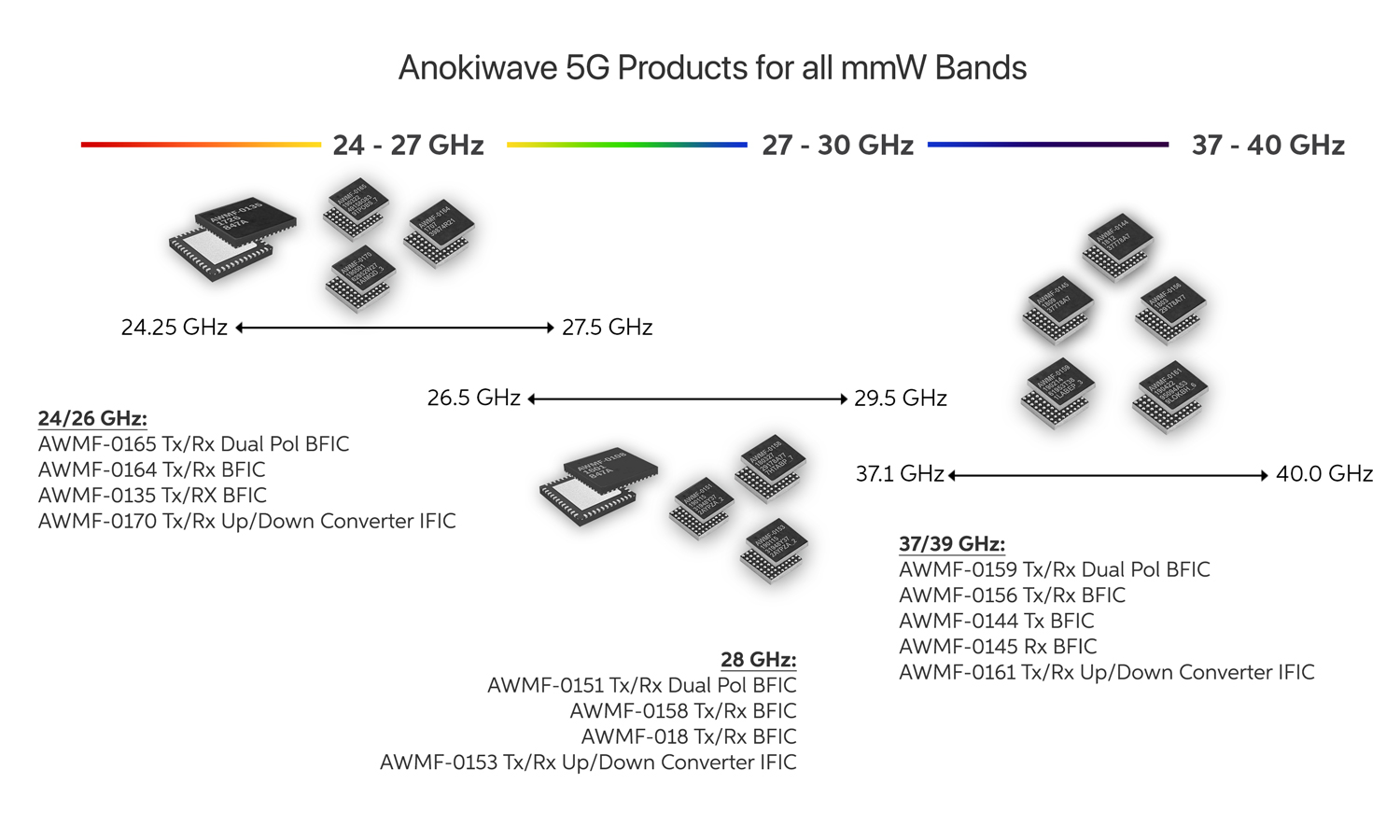mmW 5G Spectrum Auctions Aim for Higher Frequencies
 |
Ke Lu |
|---|---|
|
|
|
Anokiwave is enabling the 5G ecosystem for more than $10B of investments in the mmW spectrum with ICs featuring scalable architectures that support multiple use cases at all mmW bands.
Frequency spectrum is an invaluable component of any wireless radio system, including Fifth Generation (5G) new radio (NR) networks. Expectations for 5G are massive. Data transfer rates must far exceed any previous wireless communications technology. Not only will more people around the world require 5G services, but many different machines and devices will be connected to the Internet via 5G networks, as in Internet of Things (IoT) sensors, machine-to-machine (M2M) links, and vehicle-to-vehicle (V2V) communications as part of “smart” highways. This requires advanced wireless communications technology, but it also calls for more bandwidth than earlier generations to accommodate the massive amounts of data that will move from one point to another. It will require a large amount frequency spectrum. Large contiguous bandwidths are needed for high-speed data rates and low-latency communications for autonomous vehicles. Wireless service providers are beginning to assemble 5G networks and new frequency spectrum is an important part of those networks.
Finding Frequency
Since 2018, FCC auctions have returned over $10B in licensing fees. The first, auction 101, consisted of 3,074 28-GHz licenses by geographic area. Conducted in late 2018 and early 2019, the auction returned over $700 million in licensing fees. Auction 102 divided the spectral range around 24 GHz into two 100-MHz blocks for the lower available frequencies. Spectrum auction 102 accounted for over $2 billion in licensing fees. Most recently, auction 103 covered the upper-37-GHz, 39-GHz, and 47-GHz frequency bands. This total of 3.4 GHz available bandwidth for the three bands is the largest amount of frequency spectrum ever auctioned at one time. Licensing fees, at over $10B billion, also represented one of the largest investments in frequency spectrum within the U.S. at one time.
Building 5G Networks
Once having been awarded spectra, a licensee must integrate use of that bandwidth into its 5G network plan. A licensee for 5G spectrum from the FCC must be prepared to put that spectrum to use according to a set of clearly defined build-out requirements. Each license carries a deadline; if a licensee fails to build the infrastructure, provide the frequency coverage, or notify the FCC of the completed coverage by the deadline date, the license for the auctioned frequency is terminated automatically, and the license, location, and frequency placed in a 30-day “termination-pending” status.
The use of multiple frequency bands makes 5G networks unique compared to earlier cellular wireless generations, New and novel technologies are needed at higher frequencies and requires different antenna approaches, such as active phased array antennas capable of aiming an antenna beam at a user (rather than outward in all directions) and multiple-input, multiple-output (MIMO) antenna techniques that can achieve higher signal strength at mmW frequencies.
Markets for components for mmW antennas have traditionally been extremely limited and almost entirely for military and scientific purposes, but the shift to higher frequencies for communications, as well as advances in technology, will see the largest volume of mmW ICs ever produced. Multi-channel silicon beamformer ICs are now recognized as being fundamental to reducing the cost of the active antennas and paving the way for commercialization.

Seeing the Solution
Fortunately, the history of communications electronics technology is highlighted by the “Moore’s Law” which benefits semiconductor IC technology by enabling smaller, lower-power, higher performing silicon ICs. 5G NR systems will stand to benefit from advances in silicon devices with feature rich mmW IC solutions. As 5G mmW active antennas are being industrialized in rapidly increasing volumes, Anokiwave's silicon ICs are providing significant cost and technical advantages to the system, as well as enabling network OPEX improvements. With low-cost materials, embedded ZERO-CAL® and KINETIC-GREEN functions, field health monitors for remote monitoring, as well as the continued drive to higher power efficiency, Anokiwave is leading the way for the economic and technical improvements that ensure the success of 5G.
Anokiwave powers the 5G link with the industry’s most complete portfolio of Silicon mmW ICs. Our latest generation of mmW ICs bring a complete RF signal chain solution with scalable architectures to support use cases from macro-cells to small-cells to CPE. Anokiwave is the trusted choice of Tier-1 and -2 OEMs.
As additional mmW bands become available, you can count on Anokiwave to lead the way with innovative IC solutions. Interested in joining us? Check out some of our career openings.

